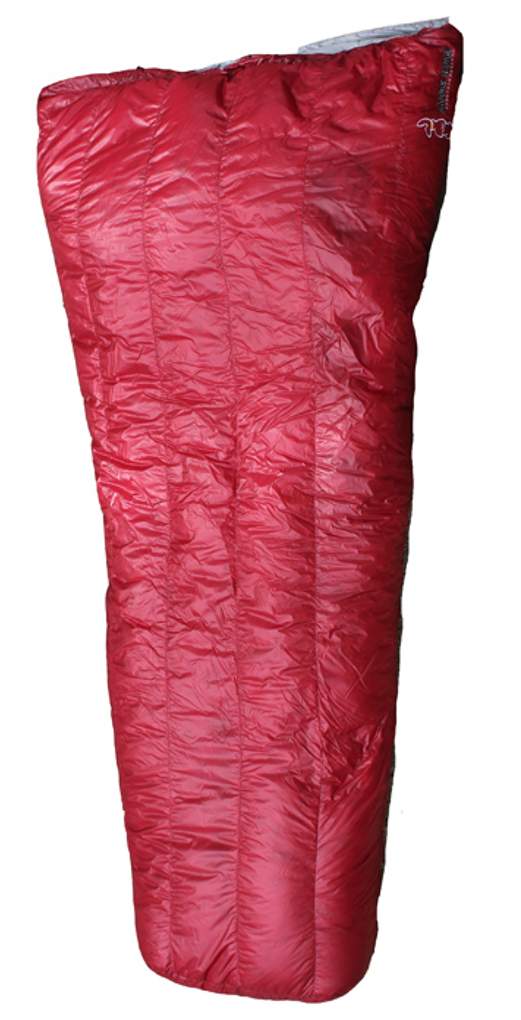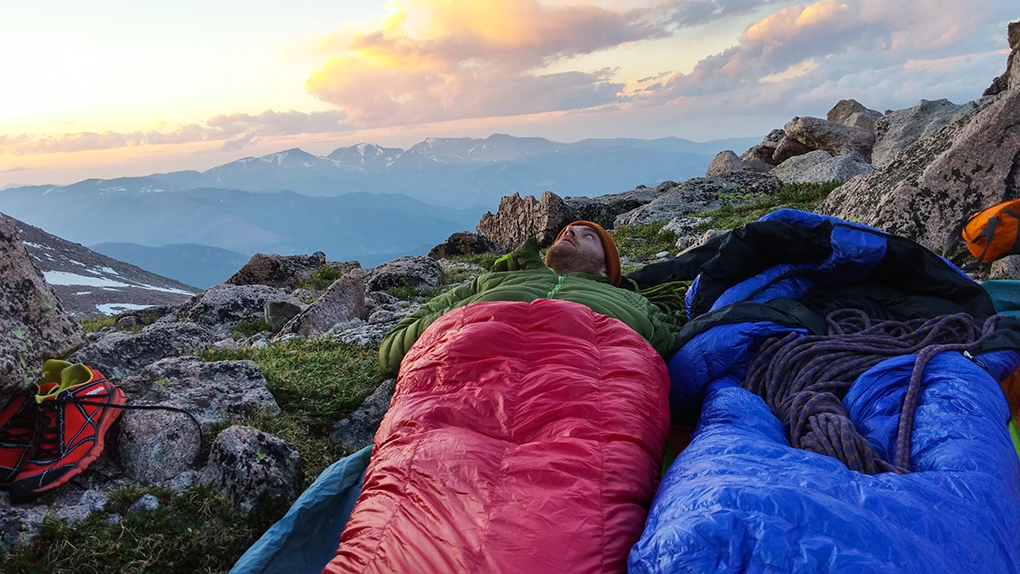
Elephant Foot Sleeping Bag
Brooks Range Mountaineering 15 degree Elephant Foot Sleeping Bag
Temperature rating: 15º F
Stated Dimensions:
• Length 59.5″‘
• Shoulder Width 55″
• Hip Width 45”
• Foot Width 42″
Stated Features:
- 850+ Fill power goose down
- 15d Nylon shell fabric with DWR treatment
- Lightweight baffle netting that allows for maximum loft and warmth
- Internal gasket for trapping air
- Ergonomic footbox
- Elastic suspenders
- Cotton Storage sack
Fill Weight: 15oz (425g)
Stated Total Weight: 20oz (566g)
MSRP: $449.95
Days Tested: 5
Test Location: Rocky Mountain National Park, Other alpine locations around CO
Intro
Brooks Range Mountaineering is a smaller outfit that specializes in fast and light backcountry equipment and backcountry EMS necessities. Their small hardware line is complemented by high-quality down gear and apparel, including jackets and sleeping bags.
The ongoing effort to produce faster, lighter ways of designing backcountry equipment requires a constant questioning of the status quo, and the Brooks Range Elephant Foot is certainly evidence of that.
Why Not Use a Normal Sleeping Bag?
The Elephant Foot originated from a simple question: Do you really need the top half of your sleeping bag? If you’ve already brought a down jacket with you for your objective, why not cut serious weight from your kit by wearing it at night in conjunction with a 2/3 length sleeping bag?
The idea behind the Elephant Foot (and similar bags like the Feathered Friends Vireo and Vireo UL) certainly passes the test for being innovative, but my first reaction was “What? That’s ridiculous.”
Weight
The numbers, however, make the question look a lot less ridiculous. The Elephant Foot, rated to 15 degrees and packed with 850+ fill goose down, weighs an incredibly light 20oz. Of that 20 ounces, a full 15 of those are from the fill.
Compare that to full size ultralight sleeping bags such as the Feathered Friends Hummingbird Nano 20 (28 ounces, with 14 ounces of down) or the Western Mountaineering Ultralight (29 ounces, with 16 ounces of down). The Feathered Friends Vireo UL, based on the same concept as the Elephant Foot, is the only bag in the same range at 15oz, but it is rated for significantly warmer nights.
Packability
The space savings are equally impressive. The 15-denier fabric is of the sort commonly found on ultralight equipment, and packs down to a very small space. Add to this the high-fill power of the down, and the Elephant Foot easily packs down to the size of a water bottle.
[Note: For the curious, denier is a term of art in the textile world that denotes the weight of a particular thread of, say, nylon. Specifically, the denier number refers to the weight in grams of 9000m of the thread, though it also essentially tells us the heft of each stretch of thread. This does not say anything about the weave of the garment made from said yarn, but it is generally true that higher-denier fabric is going to be thicker and more robust, while also being heavier and less compressible.]
Caveat
The all-important factor here is that all these fantastic weight and space savings are entirely predicated on you already packing a down jacket or something else to keep your upper body warm. If you have to bring an extra jacket along to wear with the Elephant Foot, then you have saved zero ounces relative to a full sleeping bag. This is an important consideration, but it’s also not outrageous. The Elephant Foot is rated to 15 degrees, and for trips involving a bivy near the base of a route and an alpine start, I’m definitely bringing along a warm top layer. So it at least makes some sense to wear it at night and cut down on my sleeping bag weight.
Performance
I took the Elephant Foot to Rocky Mountain National Park several times, and bivied in a variety of conditions that included light rain and temperatures between 20 and 45 degrees F. On different occasions, I used both the Brooks Range Mojave and the Arc’Teryx Cerium LT jackets with the Elephant Foot, and both combinations were plenty warm, even for the chillier nights that dipped below freezing.

Of course, your warmth at night will depend not only on the Elephant Foot, but on whatever jacket you brought. This makes assessing the true temperature rating of the bag a bit subjective, though I thought that the 15º F rating was fair. Twice I bivied in the open air, sans bivy sack, and while sleeping out at 20 degrees was none too warm, it was not overly chilly. And a bivy bag or some other minimal shelter would add a few degrees of warmth to the experience.
Durability
As with anything under the “ultralight” banner, 15-denier fabric like that used for the Elephant foot can take some abuse, but it won’t endure relentless punishment. It is light because it is thin, and sleeping out on bare rock would wreck the Elephant Foot in short order. After a season of sporadic use, I haven’t had any durability problems, but I strongly recommend taking good care of any ultralight equipment you buy.
Comfort
Sleeping with this kind of setup took a couple nights to get used to. At the top of the Elephant Foot are two adjustable elastic straps that function just like suspenders, and keep the bag from sliding down during the night.
The suspender resemblance might tempt you to put your jacket on over the Elephant Foot so that they overlap, with the jacket on the outside. But this is a tactical error. Not only are your hands doomed to the cold (who sleeps with their hands in their pockets?), but it proved to be oddly difficult (for me anyway) to sleep like this. It’s hard to describe other than to say that it’s like trying to sleep in a bed with no blankets or sheets or coverings of any sort. Even if it’s hot out and you don’t need the sheet for warmth, it’s unpleasant or perhaps just unusual to try to sleep this way.
However, sleeping with the jacket on the inside works well. The Elephant Foot is easy to get in and out of, and it’s much better in the morning to pop out of the bag already in your down jacket than to take your jacket off to get the Elephant foot off from underneath it.
Bottom Line / Who’s It For?
For all the quirks of the experience, the weight and space benefits of the Elephant Foot are substantial and are particularly advantageous for climbers or others doing ultralight backcountry trips—assuming that a warm jacket is already coming with you. At 20 total ounces, (three-quarters of which are down), the Elephant Foot is a sleeping system stripped down to bare functionality.
This is ideal for alpine climbing, which is admittedly a pretty narrow user group.
The two objections that I heard most frequently when I explained the Elephant Foot were, “But I sleep cold and have to wear my down jacket inside my sleeping bag already!” and, “But I use my down jacket as a pillow!”
These are legitimate considerations, and if you can imagine yourself saying either of these things, this system is not for you. However, if you’re willing to put a premium on saving weight and pack space, then you should strongly consider the Brooks Range Mountaineering Elephant Foot.
